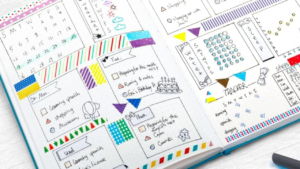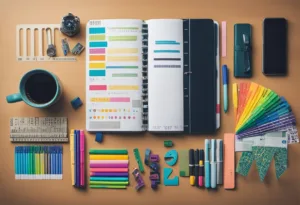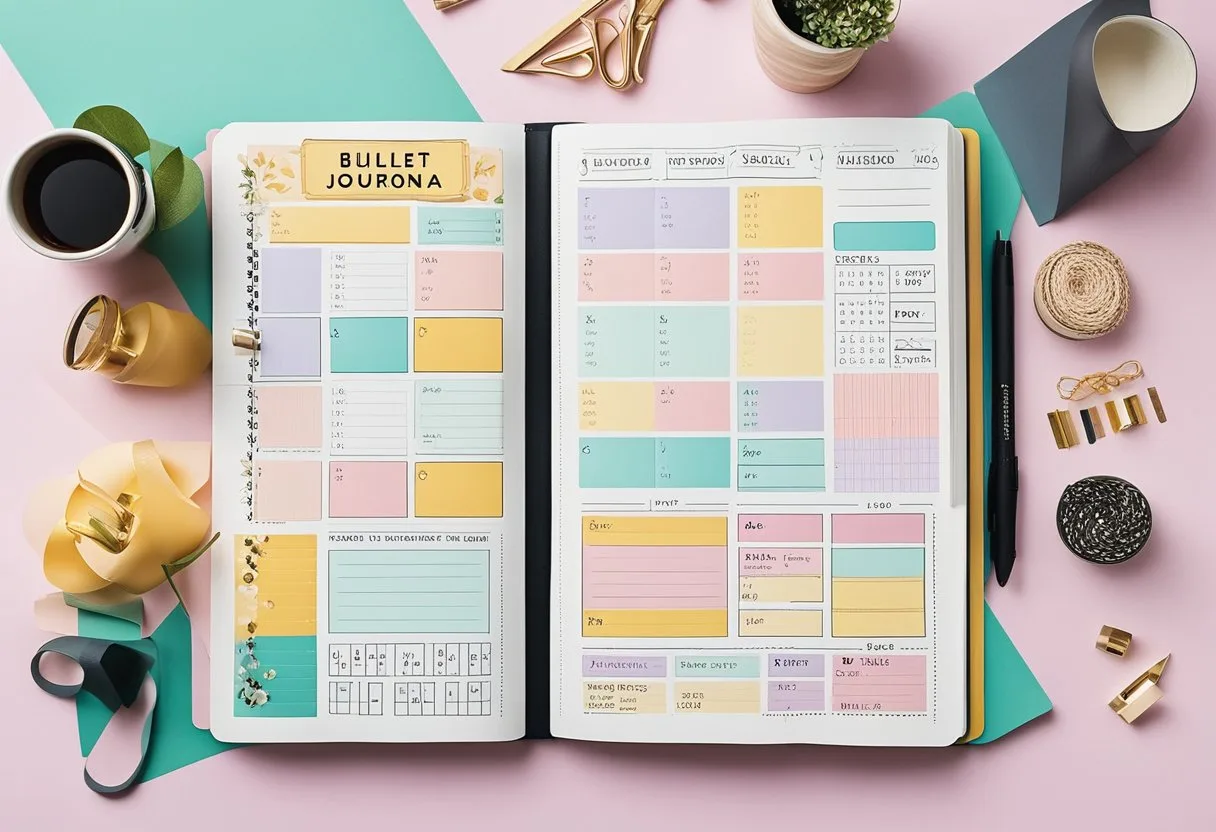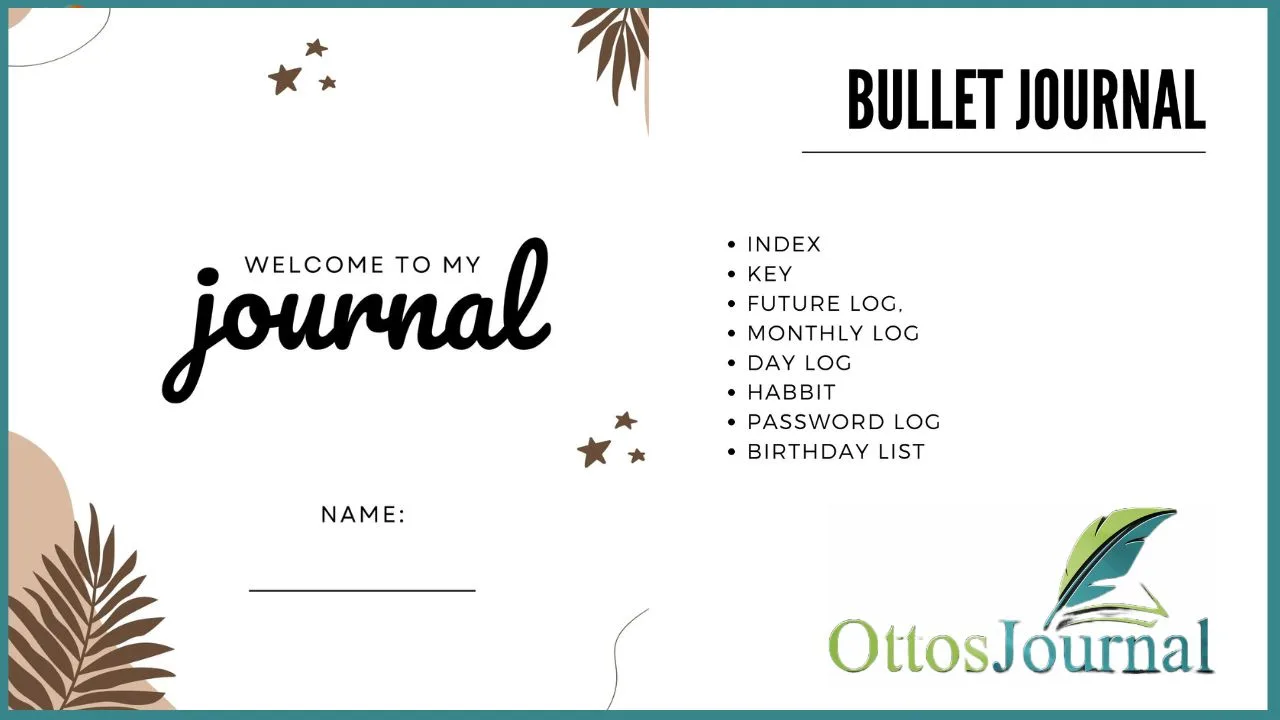Bullet journaling is a popular method of organizing one’s life through creative planning and productivity techniques. It involves using a blank notebook to create a personalized planner that can be tailored to one’s specific needs and preferences. Bullet journaling has gained popularity in recent years due to its flexibility and adaptability, as well as its ability to help users stay organized and productive. In this blog post, I will share with you 30 bullet journal page ideas to help you stay organized.
One of the key components of a bullet journal is its pages. These pages can be used to track everything from daily tasks to long-term goals, and can be customized to fit the user’s unique needs. There are countless bullet journal page ideas available online, ranging from simple layouts to more complex designs that incorporate art and creativity. Whether you’re looking to track your fitness goals, plan your meals, or keep track of your finances, there is a bullet journal page idea out there that can help you achieve your goals.
Getting Started with Bullet Journaling
Bullet journaling is a flexible system that can be customized to meet individual needs. Here are some steps to help you get started:
Choosing Your Bullet Journal
The first step in starting a bullet journal is choosing a notebook. A notebook with dotted or grid paper is recommended for bullet journaling. This type of paper allows for easy customization and organization of your pages. The size of the notebook is important. Choose a size that is easy to carry and use.
Understanding the Bullet Journal Key
The bullet journal key is a system of symbols that allow you to quickly identify different types of tasks and notes. The key is an important component of the bullet journal system, and it is essential to understand how to use it.
Some common symbols used in bullet journaling include:
- Bullet points for tasks
- Circles for events
- Dashes for notes
- Arrows for migration of tasks
Setting Up Your Index
The index is a table of contents for your bullet journal. It is used to keep track of where different pages are located in your notebook. Setting up your index is an important step in bullet journaling, as it allows you to quickly find the pages you need.
To set up your index, start by numbering the pages of your notebook. Then, create a page at the front of your notebook for your index. As you create new pages in your bullet journal, add them to your index with a short description of the page content.
30 Bullet Journal Page Ideas
Creating a diverse range of bullet journal pages can help you track various aspects of your life, explore your creativity, and improve productivity. Here are 35 bullet journal page ideas with detailed instructions:
- Monthly Log
- Start with a two-page spread. Write the month at the top and list dates and days down the left side. Reserve the right side for goals, important dates, or a to-do list. Use the left side to jot down events or tasks for each day. Decorate with themes relevant to the month.
- Habit Tracker
- Draw a grid with dates on one axis and habits on the other. Fill in the boxes when you complete a habit each day. Use different colors or symbols to represent different habits or completion levels. This visual representation can motivate you to maintain good habits.
- Mood Tracker
- Create a chart or drawing for the month with a section for each day. Assign colors or symbols to different moods and fill in the section corresponding to your mood each day. This can help you identify patterns in your mood over time.
- Sleep Log
- Use a two-page spread to track your sleep. On one side, create a graph with dates on one axis and hours on the other. Fill in the graph with the hours you sleep each night. On the opposite page, note factors that may affect your sleep like stress, caffeine, or exercise.
- Daily Gratitude Log
- Dedicate a page to write down one thing you’re grateful for each day. Decorate the page with calming images or colors that make you feel thankful. Reflecting on positive aspects of your life daily can improve your overall well-being.
- Meal Planner
- Divide a two-page spread into sections for breakfast, lunch, dinner, and snacks for each day of the week. Plan your meals ahead of time to help with grocery shopping and ensure a balanced diet. Include a section for a shopping list to make meal prep easier.
- Expense Tracker
- Make columns for the date, description, category, and amount of each expense. Track your spending to identify where you can save money. Use color-coding for different categories to visualize your spending habits better.
- Reading List
- Create a list of books you want to read. Use checkboxes to mark when you’ve started or finished a book, and leave space for a brief review or rating. You can also draw book spines on a shelf and color them in as you complete each book.
- Fitness Tracker
- Design a page to log workouts, track progress, or plan exercise routines. Include sections for date, type of exercise, duration, and notes on performance. Use motivational quotes or images to inspire regular physical activity.
- Yearly Goals
- At the start of your bullet journal, make a list of goals you want to achieve throughout the year. Break them down into actionable steps, and revisit this page monthly to check your progress and stay on track.
- Bucket List
- Create a list of experiences or achievements you want to complete in your lifetime. Use icons or doodles to represent each item and leave space to write the date you accomplished it. This can serve as a reminder of your dreams and aspirations.
- Brain Dump
- Reserve a page to freely write down all your thoughts, ideas, or tasks that come to mind. This can help clear your mind and ensure you don’t forget anything important. Later, you can organize these into tasks, events, or notes.
- Project Planner
- Outline the steps, resources, deadlines, and progress for individual projects. Use a flowchart, checklist, or timeline to visualize the project stages. This can help keep you focused and organized, especially for complex tasks.
- Vision Board
- Dedicate a page to paste images, quotes, and anything else that represents your goals and dreams. This visual collage can serve as inspiration and motivation to work towards your aspirations.
- Language Learning Tracker
- If you’re learning a new language, create a page to track your progress. Include sections for new words, grammar rules, practice exercises, and conversational phrases. Reviewing this page regularly can help reinforce your learning.
- Water Intake Tracker
- Draw a series of bottles or glasses for each day and fill them in as you drink water. This can help ensure you stay hydrated, which is crucial for health and well-being.
- Self-Care Ideas
- Make a list of activities that help you relax and recharge. Whenever you feel stressed or overwhelmed, refer to this page and choose an activity to help improve your mood.
- Inspirational Quotes
- Collect quotes that resonate with you and write them on a page. Decorate with doodles or designs that reflect the themes of the quotes. This page can be a source of comfort and motivation when you need a boost.
- Travel Planner
- Plan your trips with sections for itineraries, accommodations, activities, and packing lists. Add maps or sketches of places you want to visit. This can help make your travel experiences smoother and more enjoyable.
- Skill Development Tracker
- Choose a skill you want to improve and track your practice sessions. Note the date, duration, and what you focused on each time. This can help you stay committed to personal growth.
- Event Planning
- Organize events by listing tasks, deadlines, guest lists, and budgets. Use a timeline or calendar to visualize the planning process and ensure everything is on track.
- Wish List
- Write down items or experiences you wish to have or do. This can help you save for what you truly want and make thoughtful purchases.
- Mindfulness Page
- Create a space for meditation or breathing exercise logs. Note the date, duration, and reflections on each session to encourage a regular mindfulness practice.
- Time Tracker
- Log how you spend your time each day with a pie chart or bar graph. This can help you make more conscious decisions about how you use your time.
- Pen Test Page
- Test your pens, markers, and highlighters to see how they look on the journal’s paper. This can prevent bleed-through and help you choose the best writing instruments for your journal.
- Cleaning Schedule
- Set up a weekly or monthly cleaning schedule to keep your living space tidy. Include tasks for each room and check them off as you complete them.
- Recipe Keeper
- Dedicate pages to write down your favorite recipes or ones you want to try. Include ingredients, instructions, and a photo or drawing of the finished dish.
- Online Course Tracker
- If you’re taking online courses, track your progress, key takeaways, and assignment due dates. This can help you stay on top of your education.
- Garden Planner
- Plan your garden layout, plant types, and sowing/harvesting times. Track the growth and health of your plants over time.
- Monthly Reflection
- At the end of each month, write down what went well, what didn’t, and what you learned.

Designing Your Bullet Journal Layouts
When it comes to designing your bullet journal layouts, you have a lot of creative freedom. You can keep it simple or make it as fun and colorful as you like. The key is to find a layout that works for you and helps you stay organized.
Creating a Monthly Spread
A monthly spread is a great way to get an overview of your month at a glance. You can include a calendar, important dates, and any tasks or events you need to remember. When designing your monthly spread, consider using a color scheme or theme to make it visually appealing.
Designing a Weekly Spread
A weekly spread is a more detailed view of your week. You can include a to-do list, appointments, and any other tasks or goals you want to accomplish. When designing your weekly spread, consider using different sections or columns for different categories, such as work, personal, or fitness.
Incorporating Daily Spreads
A daily spread is a more detailed view of your day. You can include a schedule, to-do list, and any notes or thoughts you want to remember. When designing your daily spread, consider using symbols or icons to represent different tasks or events. This can make it easier to quickly scan and prioritize your tasks for the day.
When designing your bullet journal layouts, it’s important to find a balance between creativity and functionality. Your layouts should be visually appealing, but also easy to use and understand. By experimenting with different spreads and layouts, you can find the perfect system that works for you.
Tracking Habits and Goals
Keeping track of habits and goals is one of the most important aspects of bullet journaling. By tracking these, users can monitor their progress and make adjustments as needed to achieve their desired outcomes. In this section, we will explore some of the different types of trackers that can be used in a bullet journal.
Building a Habit Tracker
A habit tracker is a simple and effective way to monitor daily habits. Users can create a table with a list of habits they want to track and mark off each day they complete the habit. This can be useful for tracking habits such as drinking enough water, taking daily vitamins, or meditating.
Maintaining a Goal Tracker
A goal tracker is a tool used to track progress towards achieving specific goals. Users can create a table with a list of goals they want to achieve and mark off each milestone as they get closer to their goal. This can be useful for tracking goals such as weight loss, fitness, or reading.
Using a Budget Tracker
A budget tracker is a tool used to track income and expenses. Users can create a table with a list of expenses and income sources and track their spending and earnings. This can be useful for tracking expenses such as utility bills, groceries, or entertainment.
Bullet journaling provides a simple and effective way to track habits, goals, and budgets. By using trackers, users can monitor progress and make adjustments as needed to achieve their desired outcomes. Whether it’s a habit tracker, goal tracker, or budget tracker, bullet journaling can help users stay organized and focused on their goals.
Enhancing Personal Well-being
Bullet journaling is an excellent tool to enhance personal well-being. By creating pages that focus on gratitude, self-care routines, and mental health, individuals can improve their productivity, mood, and overall health.
Starting a Gratitude Log
One way to enhance personal well-being is by starting a gratitude log. This log can include anything from daily affirmations to things that the individual is thankful for. By focusing on the positive aspects of their life, individuals can improve their mood, increase their productivity, and reduce their stress levels.
Reflecting in a Brain Dump Page
Another way to enhance personal well-being is by creating a brain dump page. This page can be used to reflect on the individual’s thoughts, feelings, and emotions. By writing down their thoughts, individuals can clear their mind and reduce their stress levels. This page can also be used as a sleep tracker or mood tracker, allowing individuals to reflect on their mental health and make necessary changes to their lifestyle.
Focusing on Self-Care Routines
Finally, bullet journaling can be used to focus on self-care routines. By creating pages that include self-care activities, individuals can prioritize their mental and physical health. This can include anything from meditation and exercise to skincare and healthy eating. By incorporating these activities into their daily routine, individuals can improve their overall well-being and lead a healthier lifestyle.
Bullet journaling can be an effective tool to enhance personal well-being. By creating pages that focus on gratitude, self-care routines, and mental health, individuals can improve their productivity, mood, and overall health.

Organizing Activities and Ideas
Keeping a Cleaning Routine
One of the most effective ways to keep a clean and organized living space is by establishing a cleaning routine. This can be done by creating a cleaning schedule that includes daily, weekly, and monthly tasks. A bullet journal can be used to create and track this schedule. By setting aside specific times for cleaning, individuals can ensure that their living space remains tidy and clutter-free.
Planning with a Meal Planner
Meal planning is another effective way to stay organized and on top of daily tasks. By creating a meal planner, individuals can plan out their meals for the week, ensuring that they have all the necessary ingredients on hand and reducing the need for last-minute trips to the grocery store. A bullet journal can be used to create a meal planner, with sections for breakfast, lunch, and dinner, as well as snacks and desserts.
Collecting Ideas on a Vision Board
A vision board is a tool that can be used to help individuals visualize their goals and aspirations. By creating a vision board in their bullet journal, individuals can collect images and ideas that inspire them and keep them motivated.
This can include anything from pictures of their dream home to inspirational quotes and affirmations. By regularly reviewing their vision board, individuals can stay focused on their goals and work towards achieving them.
A bullet journal can be an effective tool for organizing activities and ideas. By using it to create schedules, meal planners, and vision boards, individuals can stay on top of their daily tasks and work towards achieving their goals.
Frequently Asked Questions
What pages should I put in my bullet journal?
The pages you should put in your bullet journal will depend on your personal needs and preferences. However, some common pages include a future log, monthly, weekly, and daily logs, as well as customizable collections such as goal setting and gratitude logs.
What do I write in my bullet journal?
You can write anything in your bullet journal that you want to keep track of or remember. This can include tasks, events, notes, ideas, goals, habits, and more. The beauty of a bullet journal is that it can be customized to fit your own unique needs.
How many pages is good for a bullet journal?
The number of pages in a bullet journal will depend on how much content you want to include. Some people prefer to have a smaller, more portable journal with fewer pages, while others prefer a larger journal with more pages. It’s important to find a balance that works for you.
How do you decorate a bullet journal page?
There are many ways to decorate a bullet journal page, including using stickers, washi tape, colored pens, and drawings. The key is to find a style that you enjoy and that fits with your personal aesthetic.
What are some creative themes for decorating monthly pages in a bullet journal?
Some creative themes for decorating monthly pages in a bullet journal include seasonal themes, travel themes, nature themes, and more. The key is to find a theme that you enjoy and that inspires you.
How can I effectively utilize a bullet journal for work-related organization?
To effectively utilize a bullet journal for work-related organization, you can create pages for tasks, projects, meetings, and deadlines. You can also use symbols and color coding to help prioritize tasks and track progress.
What are essential pages to include in a bullet journal for students?
Essential pages to include in a bullet journal for students include class schedules, assignment trackers, exam schedules, and study notes. You can also create pages for extracurricular activities, personal goals, and self-care.
Can you suggest some simple yet functional page layouts for beginners in bullet journaling?
Some simple yet functional page layouts for beginners in bullet journaling include a daily log, a weekly log, a monthly log, and a habit tracker. These layouts can be customized to fit your own personal needs and preferences.
What are some unique ways to personalize pages in a bullet journal for adults?
Some unique ways to personalize pages in a bullet journal for adults include using photographs, incorporating inspirational quotes, and creating pages for personal goals and aspirations. The key is to find a style that you enjoy and that reflects your own personality.
How can I incorporate a bullet journal template to streamline my planning process?
To incorporate a bullet journal template to streamline your planning process, you can use pre-made templates or create your own. Templates can be used for daily, weekly, or monthly planning, as well as for specific projects or tasks. The key is to find a template that works for you and that you can easily customize as needed.



